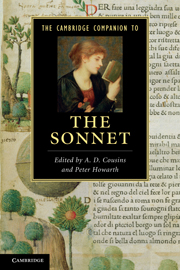Book contents
- Frontmatter
- Introduction
- 1 Contemporary poets and the sonnet
- 2 The sonnet and the lyric mode
- 3 The sonnet, subjectivity and gender
- 4 The English sonnet in manuscript, print and mass media
- 5 European beginnings and transmissions
- 6 Desire, discontent, parody
- 7 Shakespeare’s Sonnets
- 8 Sacred desire, forms of belief
- 9 Survival and change: the sonnet from Milton to the Romantics
- 10 The Romantic sonnet
- 11 The Victorian sonnet
- 12 The modern sonnet
- 13 The contemporary sonnet
- Further reading
- Index
1 - Contemporary poets and the sonnet
a trialogue
Published online by Cambridge University Press: 28 May 2011
- Frontmatter
- Introduction
- 1 Contemporary poets and the sonnet
- 2 The sonnet and the lyric mode
- 3 The sonnet, subjectivity and gender
- 4 The English sonnet in manuscript, print and mass media
- 5 European beginnings and transmissions
- 6 Desire, discontent, parody
- 7 Shakespeare’s Sonnets
- 8 Sacred desire, forms of belief
- 9 Survival and change: the sonnet from Milton to the Romantics
- 10 The Romantic sonnet
- 11 The Victorian sonnet
- 12 The modern sonnet
- 13 The contemporary sonnet
- Further reading
- Index
Summary
This conversation was initiated by poets’ individual answers to the editor’s questions, and then developed as they responded to each other’s replies.
Auden once said that the sonnet was a trap for new writers because it had too much history to it. How do you help aspiring sonnet writers manage the reverberating meanings and connotations of the form?
MT: Part of the pleasure of writing (and teaching) sonnets is that you have an instant sense of community. The sonnet relieves us of our loneliness; as soon as you settle into its parameters, the conversation begins. As Christopher Ricks says, ‘the one thing allusion provides and calls upon is company (the society of dead poets being a living resource in its company)’. I think about Heaney’s ‘Out of Shot’ (from District and Circle), where he quietly calls upon several fellow poets (Petrarch for the rhyme scheme, Yeats for content). By using the words ‘lost’ and ‘loosed’ repeatedly, Heaney echoes the prophetic Yeats, ‘Mere anarchy is loosed upon the world, / The blood-dimmed tide is loosed’ from ‘The Second Coming’, which is not a sonnet but hints at the dimensions of one as the first stanza is eight lines long and the second is fourteen lines; this poem is definitely a sounding-board or springboard for Heaney’s sonnet (of a donkey, he writes, ‘Loosed from a cart that had loosed five mortar shells / … / Lost to its owner, lost for its sunlit hills.’). Note how Heaney positions his rhyming partners at line’s beginning and middle, not line’s end.
- Type
- Chapter
- Information
- The Cambridge Companion to the Sonnet , pp. 6 - 24Publisher: Cambridge University PressPrint publication year: 2011
- 1
- Cited by



